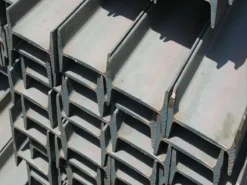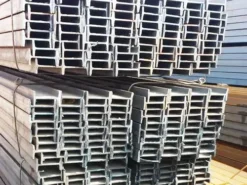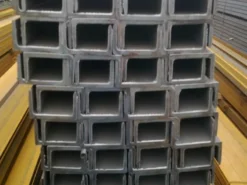An economical cross-section profile with a cross-section shape similar to the capital Latin letter H, also called universal steel beam, wide edge (edge) I-beam or parallel flange I-beam. The cross section of H-shaped steel usually includes two parts: web and flange plate, also known as waist and edge.
-Features:
The inner and outer sides of the flanges of H-shaped steel are parallel or close to parallel, and the flange ends are at right angles, hence the name parallel flange I-beam. The web thickness of H-shaped steel is smaller than that of ordinary I-beams with the same web height, and the flange width is larger than that of ordinary I-beams with the same web height, so it is also called wide-edge I-beam. Determined by its shape, the section modulus, moment of inertia and corresponding strength of H-shaped steel are significantly better than ordinary I-beams of the same unit weight. Used in metal structures with different requirements, it shows its superior performance whether it bears bending moment, pressure load, or eccentric load. It can greatly increase the load-bearing capacity compared with ordinary I-beams and save 10% to 40% of metal. H-shaped steel has wide flanges, thin webs, multiple specifications, and flexible use. It can save 15% to 20% of metal when used in various truss structures. Because the inner and outer sides of the flange are parallel and the edge ends are at right angles, it is easy to assemble and combine into various components, thus saving about 25% of the welding and riveting work, which can greatly speed up the construction speed of the project and shorten the construction period.
-Classification:
There are many product specifications of H-shaped steel, and the classification methods are as follows. (1) According to the flange width of the product, it is divided into wide flange, medium flange and narrow flange H-shaped steel. The flange width B of wide-flange and medium-flange H-shaped steel is greater than or equal to the web height H. The flange width B of narrow-flange H-shaped steel is approximately equal to one-half of the web height H. (2) According to product use, it is divided into H-shaped steel beams, H-shaped steel columns, H-shaped steel piles, and extremely thick flange H-shaped steel beams. Sometimes parallel leg channel steel and parallel flange T-shaped steel are also included in the scope of H-shaped steel. Generally, narrow-flange H-shaped steel is used as the beam material, and wide-flange H-shaped steel is used as the column material. Accordingly, it is also called beam-type H-shaped steel and column-type H-shaped steel. (3) According to the production method, it is divided into welded H-shaped steel and rolled H-shaped steel. (4) According to the size, it is divided into large, medium and small H-shaped steel. Generally, products with web height H above 700mm are called large, those with web height H between 300 and 700mm are called medium, and products with web height H less than 300mm are called small. By the end of 1990, the world’s largest H-shaped steel web had a height of 1200mm and a flange width of 530mm.
-Advantages of Hot Rolled H Beam
1.Steel structures based on hot-rolled H-shaped steel have a high degree of industrial manufacturing, are convenient for mechanical manufacturing, intensive production, high precision, easy installation, and easy to ensure quality. They can be built into real house manufacturing factories, bridge manufacturing factories, industrial plant manufacturing factories, etc. .
2.The construction speed of the project is fast, the area is small, and it is suitable for all-weather construction and is less affected by climate conditions.
3.Increase the effective use area of the structure
4.Compared with welding H-shaped steel, it significantly saves labor and materials, reduces raw material, energy and labor consumption, has low residual stress, and has good appearance and surface quality.
5.Facilitates machining, structural connection and installation. Also easy to dismantle and reuse.











